
Most men don’t think about how to shave their neck until they start seeing hairs sprouting from below the Adam’s apple. But a little extra attention when shaving can mean the difference between a clean, well-groomed look and an embarrassing neckbeard–or a neck full of shaving nicks. Here is a complete guide to getting a clean shave on your neck without irritation!
Why Is Shaving The Neck So Hard?
It’s no secret that shaving can be annoying for some. But why is it that shaving your neck seems to be especially difficult? There are a few reasons for this.
For one, the skin on your neck can be notoriously sensitive. That means that you’re more likely to get razor burn or ingrown hairs when you shave your neck than other areas of your body.
Secondly, the hair on your neck is often coarser and thicker than the hair on other parts of your body. That makes it more difficult to get a close shave without nicking yourself.
Finally, the area around your neck is often full of creases and curves. That makes it harder to maneuver your razor and get a clean, close shave.
So if you’re struggling to get a smooth shave on your neck, don’t feel bad – it’s actually pretty common.
What Are The Benefits Of Shaving The Neck?
Shaving the neck can help you look neat and clean, make the skin look smoother, and you may feel more comfortable wearing certain types of clothes (especially in hot weather).
What Are The Dangers Of Shaving The Neck?
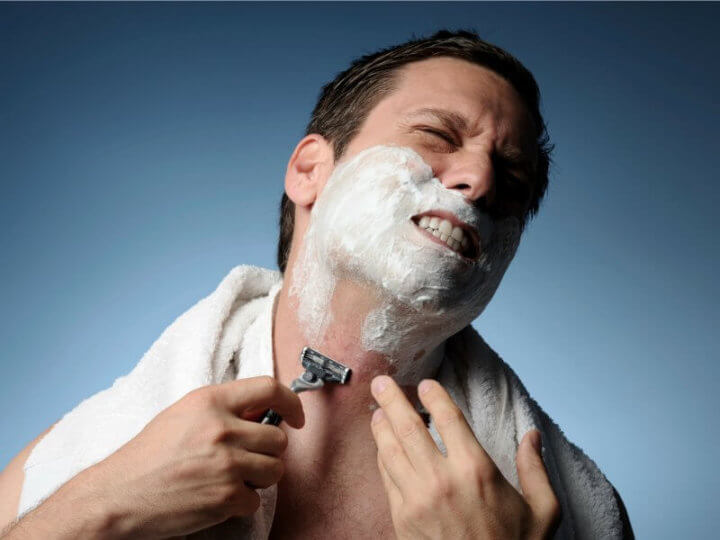
The main disadvantage to shaving the neck is that it can lead to razor burn, which can be uncomfortable. It can also cause ingrown hairs or razor bumps. If you have sensitive skin, you should be very careful when shaving the neck.
So Is It Safe To Shave Your Neck?
Shaving your neck with a razor can be safe if you take the necessary precautions. First, make sure you’re using a clean, sharp razor. Second, prepare your skin carefully. Third, shave with respect to the hair’s direction of growth. Fourth, after shaving, rinse thoroughly to remove lather residue. Finally, apply a good aftershave or moisturizer to keep the skin hydrated and reduce irritation.
If you follow these simple tips, shaving your neck with a razor can be a safe and easy way to keep your appearance neat and tidy.
The First Step To A Great Shave On The Neck Without Irritation: Understanding How Hair On The Neck Grows
The “grain” of the beard–the direction(s) the hairs grow in–can be completely counterintuitive when it comes to the neck. They can even sometimes grow in a circular pattern. Understanding how the hair grows on your neck is the first step in overcoming shaving problems there. To accomplish this, create a map of your beard with a mapping aid like this one:
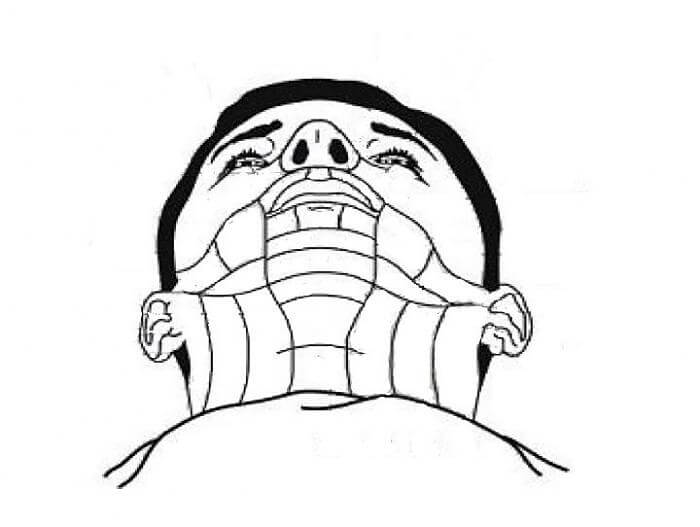
Let your beard grow out for a day or so then gently stroke your hand over your beard in different directions to determine the grain of the beard. Some directions will feel rough, other directions will feel smoother. The direction that is the smoothest is the direction of your beard grain. If you want a confirmation, try using a plastic card or a thick piece of paper to stroke your beard with.
Using a mirror determine the direction(s) your beard is growing in and sketch that onto the face map: writing arrows in the direction of growth in each box will help you understand how to best shave those areas.
Shaving with the grain initially is one of the basic concepts in shaving, particularly important if you are using a multi-blade cartridge razor (more on this in a moment). It’s a bit less important with a double-edged razor (you can “cheat” a little and follow the predominant direction without worrying about every twist and turn), but still necessary to keep in mind. Carefully reducing the beard in stages is the key take-away here.
What Is The Best Razor For Shaving The Neck? Choose the Right Razor (And Blade)
Generally, many shavers who experience neck trouble report improvement by using the combination of a razor with a relatively small blade exposure (a “sensitive” razor) along with a high performance blade. Let’s examine some options.
Cartridge Razor
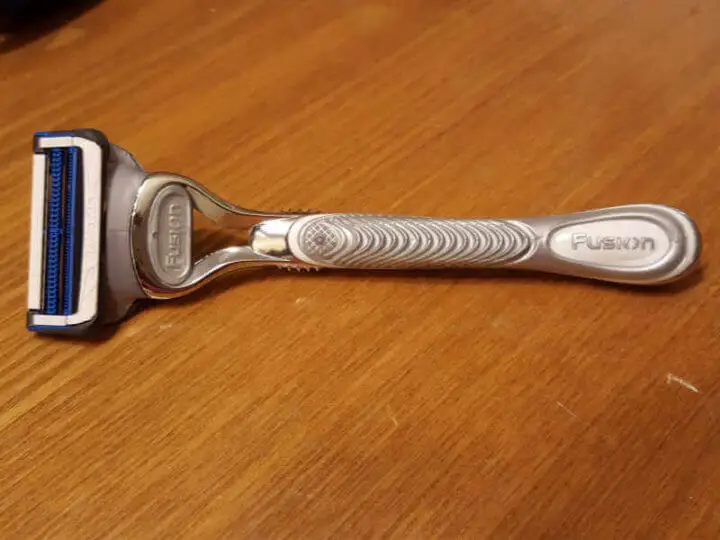
Mass-market razors with multi-blade cartridges have more interactive variables given their design but generally speaking cartridge razors with a head pivot, fewer blades, and lower blade angles will be easier on the neck. Blade make-up and angle(s) in the cartridge are specified by the cartridge manufacturer so it is worthwhile considering alternatives.
It may take some experimentation to see which razor design works for you, but it will be worth the effort. The modern cartridge razor’s head pivot may help you get a more consistent shave on the neck but remember the neck is a notoriously sensitive area and every additional blade is another chance for irritation and/or ingrown hairs.
Try to avoid multi-blade cartridge razors that use “life and cut” technology.
One specific mass-market cartridge razor I do recommend for those having trouble shaving the neck is the Gillette SkinGuard.
“Safety” Razor (And Blade)
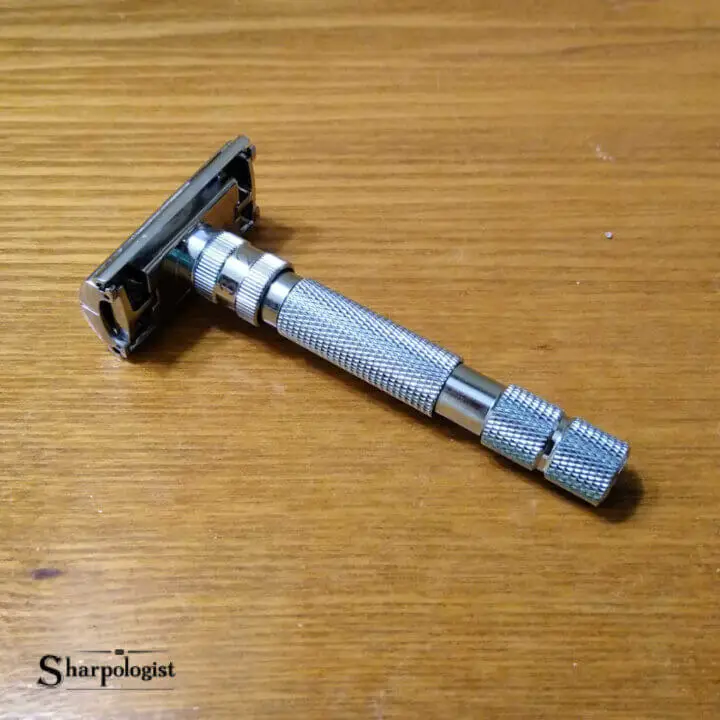
Single blade “safety” razors like the classic double edge (“DE”) razor require more attention to detail while shaving but offer more flexibility: there are a number mild (“gentle”or “comfortable”) razor head designs and a variety of blade specifications (double edge razor blades may all “look” the same but there are many different ways the blades may be sharpened and coated).
Others have had good results by changing to a “slant bar” DE razor because they don’t cut hair head-on but at an angle. Getting the hang of a slant bar razor can be a little intimidating for some though.
Adjustable safety razors like the Merkur Progress, Parker Variant, or Rex Ambassador are another option: their blade exposure can be “dialed up” or “dialed down” as necessary depending on where you are shaving. However, using an adjustable razor is a little controversial because there can be a tendency with newcomers to over-experiment with the settings.
And remember that while blades may look alike they may not behave the same! There are a myriad of specifications–metallurgy, grinding, coating, etc.–so it’s a good idea to try different brands to see how they perform.
Best Of Both Worlds?
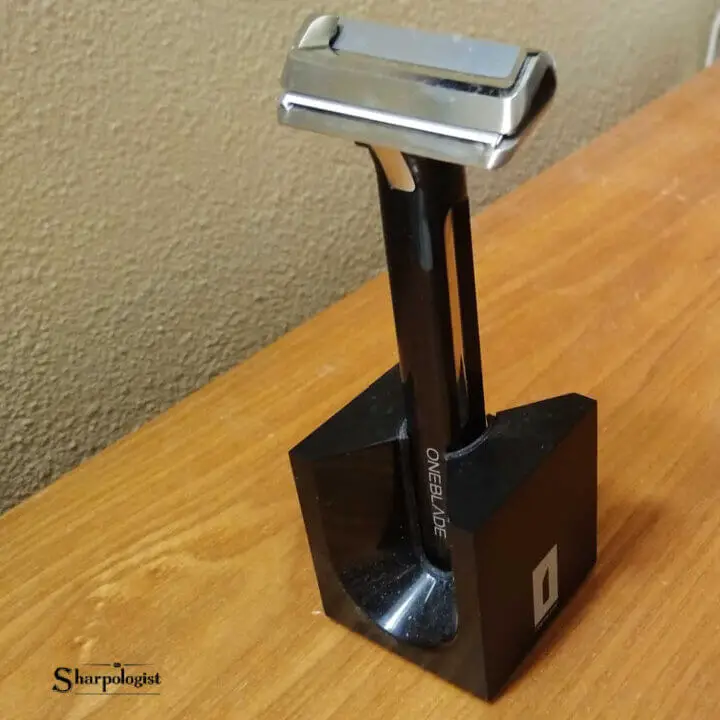
Finally, there is the relatively recent development of single blade razors that have pivots like a cartridge razor. These include the OneBlade, Focus Dynamic, the Leaf razor (affiliate link), and the new High Proof Razor. These may offer the “best of both worlds” with the shave consistency of a pivot razor plus a lower chance of neck irritation and ingrown hair with the use of a single blade.
Personally, I have had fantastic results with a OneBlade Genesis razor (affiliate link).
What About An Electric Razor?
What about using an electric razor on the neck? When it comes to electric razors, there are two main types: rotary and foil. Which is better for shaving the neck? It really depends on personal preference. Some find that a rotary shaver gives a closer shave, while others find that a foil shaver is less irritating.
It is worth noting though that electric razors generate heat, which can lead to redness and irritation on sensitive skin.
This article will concentrate on using manual (cartridge and safety) razors.
The Importance Of Water On The Neck

Properly preparing the skin of the neck for shaving is often overlooked: copious amounts of warm water and gently cleaning the skin on the neck with a cleanser specifically made for the face is important here, particularly if you are troubled by ingrown hairs on the neck. Try a good, thorough cleansing of the area before putting razor to skin.
A fair number of people have reported noticeable improvement of neck shaving problems by using cold water instead of hot. It may be because warm water brings corpuscles closer to the surface of the skin, making redness and nicks more likely.
If you’re not getting the results from a fully warm water shave, try a warm water prep followed by a cold water shave. Then try a complete cold water routine (prep and shave) to see if there is a difference.
Your shave may not be as luxurious-feeling as you would like but if it reduces problems the technique may be worth a try.
Pre-Shave Products?
Some have found that applying pre-shave oil on the neck (after a proper prep!) can help reduce irritation, too. After cleansing, keep the skin wet, apply the oil, and then apply your shaving lather.
“Stand alone” shave oils like Pacific Shaving Oil, Village Barber Shave Oil work exceptionally well underneath lather, too.
There are other types of pre-shave products besides oil. In fact, they may be better than oil for shaving the neck because they may be less likely to clog pores.
What Are The Right Kinds Of Shaving Creams, Soaps, And Gels For Shaving The Neck?
If you’re using a shaving product that comes out of a pressurized can you should consider another product. All things being equal, anything out of a pressurized can tends to dry out the skin because of the can’s propellant. Then they have to try to make up for the drying effect with chemical lubricants. Besides, have you read the ingredient list? Every additional ingredient is just one more thing that your skin might react to. So at least use a product out of a squeeze tube.
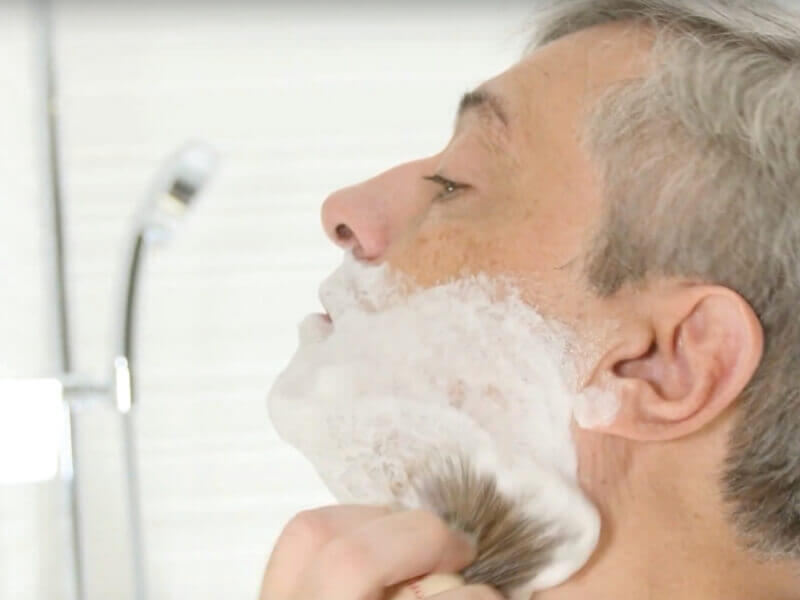
For the best experience I think you should use a good lathering shave cream applied with a shaving brush. Using a shaving brush is not only a great way to gently remove tiny bits of debris but also keep water next to the skin, and surround every little hair with lather. It may take a little more time but your efforts will be rewarded.
What about a shave soap? Good lathering shave soaps can work well too, but I have found that shave creams provide extra cushion and protection to the skin over shave soaps.
Combining cream and shave soap–sometimes called “superlather”–can be exceptionally effective with providing an incredibly slick and cushioning layer for shaving the neck!
Aftershaves
If you’re predisposed to ingrown hairs or razor bumps on the neck you should avoid heavy aftershave balms, waxes, or gels that may dry into a thick layer on the skin. Instead use a lighter aftershave balm or low alcohol splash.
Aftershave products containing Salicylic or Acetylsalicylic acid are designed to reduce inflammation and expose the ingrown hair to the air.
How Often Should You Shave Your Neck?
It may seem counterintuitive but shaving more often may reduce neck problems: the longer the stubble is, the more difficult the cutting may be. If you have thick hair try shaving daily, or at least every-other-day. For lighter hair, you can get away with shaving a couple times a week. Experiment to find the best method for you.
What Is The Best Time To Shave Your Neck?
The best time to shave your neck is right after you have showered. Showering will soften your hair and make it easier to shave.
And consider shaving at least 20 minutes after you rise in the morning but before eating breakfast, or just before you go to bed for the day. The reasoning for this may be a little ambiguous but it makes a difference for some.
What Are Some General Tips For Shaving The Neck?
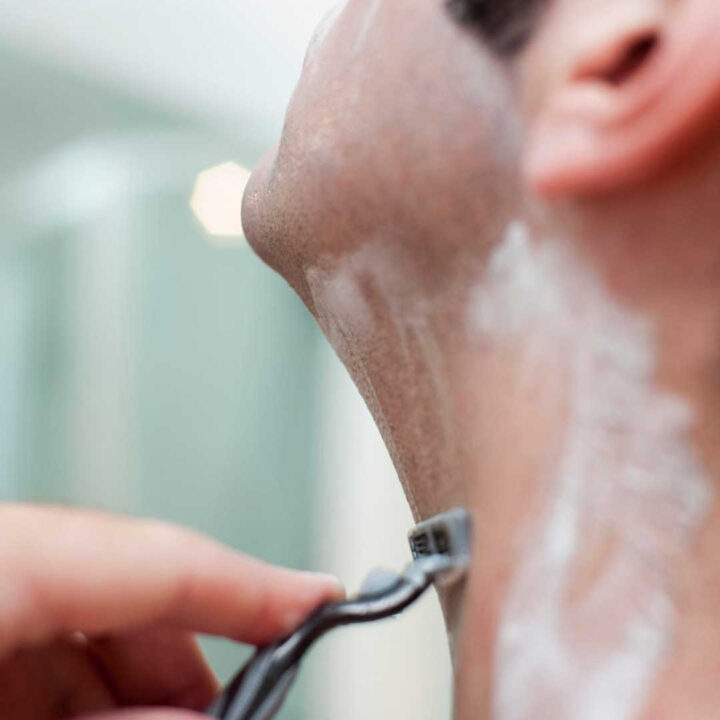
I’ll get to the actual step-by-step process of shaving the neck in a moment but here are some tips to keep in mind:
“Timing”
Assuming you’re shaving your face and neck, lathering your neck first and shaving it last will give the stubble there the longest possible time to hydrate and soften.
Pressure
If you’re using an old school razor you’re going to have to remember to use little to no pressure on the razor. Modern cartridge razors are engineered to help compensate for too much pressure on the skin but they can only go so far.
No matter what kind of razor you use, holding the razor at the very bottom of the handle will usually help reduce the pressure of the blade on the skin. Alternatively you can try holding the razor by its center-of-gravity (balance point) but this may not work well with every razor.
Angle
Modern blade cartridges set the blades at a specific angle determined by the designers, who engineer it to an angle they think is best for most people. So there’s not much you can do about it short of trying a different model of razor.
But shavers who use old school safety razors have the ability to change the angle of blade as it meets the skin by the way they hold the razor’s handle. In the case of the neck you will want to try to keep a shallower angle on the razor (e.g. “riding the cap”).
Try holding the top of the razor to your neck then slowly rock the razor down until the blade just makes contact with the skin. Try to maintain that shallow angle as you’re shaving the neck. Admittedly that can be a challenge, since the neck is a pretty curvy place.
Flattening The Skin

Most people think they need to stretch the skin to get a smooth shave. But what you really need to do is flatten the skin. It may sound like the same thing but it’s really easy to over-stretch the skin and that’s a prescription for ingrown hairs and razor burn.
One way to flatten the skin on most of the neck without over-stretching is to lean forward from the waist and tilt your head up slightly. You may need to steady yourself with your other hand while you’re doing this but it works really well for me.
Another way to flatten the areas just under the jaw is to tilt your head down and back, and flatten the jowl area. You’ll look like a bullfrog but some people find it useful to catch those areas.
What about the Adam’s apple? There are a couple things you can do to shave that area too. One is to swallow and try to hold the swallow. You won’t be able to hold it for more than a second or so but that should be long enough to make a shaving stroke on the area.
Another alternative is to carefully slide the skin over the Adam’s Apple to one side. Be careful not to over-stretch it though.
Changing Grain Directions
If the grain is in a curving or even circular pattern on a section of neck, you may find that a single predominant direction will work adequately for part of the pattern. The only way to know for sure is to try it.
Over-Shaving
Resist the urge to immediately repeat a shave stroke over the same spot over and over again! If you can pay closer attention to your shave stroke and avoid repeating them in the same pass you can not only save time but also avoid irritation. Read “How To Shave Efficiently” for more detail on over-shaving.
Stroke Length
Keep your shaving strokes fairly short–maybe one or two inches. Do not make long, sweeping strokes with the razor.
What Are The Steps For Shaving Your Neck Without Getting Razor Bumps, Cuts, Or Burn?
- Prepare the area thoroughly, either by shaving right after showering or cleaning the area with a gentle cleanser made specifically for the face and rinsing with copious amounts of water. Warmer water will accelerate the beard softening process but it could take up to three minutes.
- Optionally, apply a pre-shave product before lathering.
- Lather the area with a good shaving lubricant.
- Shave with the grain of the hair. If you are shaving several areas (like face and neck), lather the neck first and shave it last). Remember to try to keep the area of skin being shaved as flat as possible and use just enough pressure on the razor to keep it in contact with the skin. Keep the shave stroke short.
- After this first pass, if you have gotten any nicks or irritation at this point move on to the “finishing” routine (below) and re-examine your shaving routine.
- If your first pass is successful, rinse the area briefly and re-apply lather. This time shave across the grain of the hair (90 degrees away).
- Again, rinse briefly and examine the area for irritation. If you are unsatisfied with the closeness of the shave, re-apply lather and shave across the grain from the opposite direction of the previous pass.
- If you don’t have any irritation at this point you might try for re-lathering and shaving against the grain but this is usually not recommended.
Finishing
A thorough post-shave rinsing is a good idea, and essential if you are experiencing those little pimple-looking white-head things: it may be caused by lather residue clogging pores. Rinse with lots of warm water, followed by cool water. For extra insurance consider soaking a cotton make-up pad with a good skin toner, hydrosol, or Witch Hazel and wiping down the area between the warm water and cool water rinses. Some suggest using an alum block as well, followed by another cool water rinse, but there’s some disagreement among shave ‘enthusiasts’ about that….
Finally, follow up with a good aftershave product and/or moisturizer as previously discussed.
What Are The Common Mistakes People Make When Shaving Their Neck?
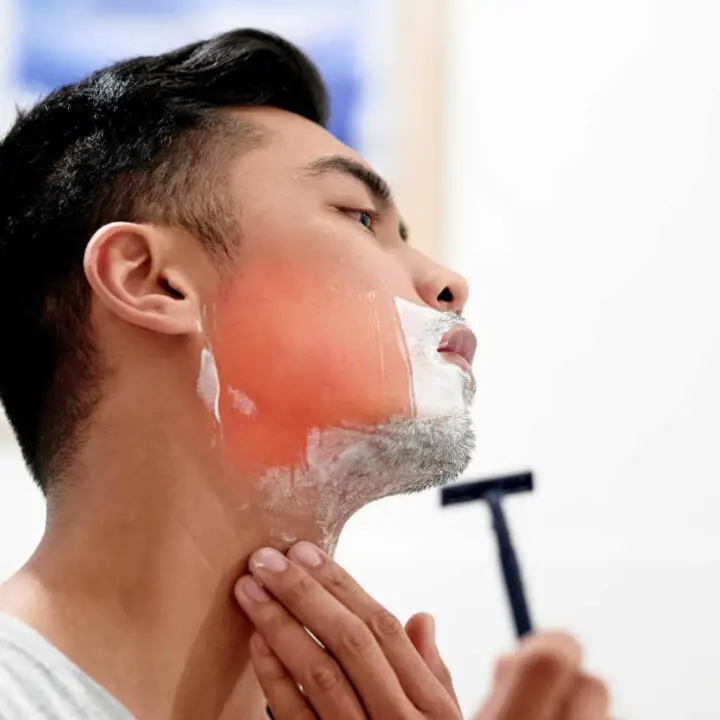
There are a few common mistakes people make when shaving their neck.
- Not preparing the skin properly.
- Shaving against the grain, which can cause irritation and ingrown hairs.
- Using a razor with a cartridge or blade that has dulled.
- Using a razor with too many blades (or the equivalent, over-shaving an area).
- Using a poor quality shaving cream that doesn’t allow the razor to glide easily.
- Not keeping the neck skin flat, which can lead to cuts, scrapes, and snags.
The best way to avoid these mistakes is to practice regularly using good products and following the correct technique guidelines. Shaving your neck correctly will make you look sharper and more professional.
Settle for Less?
Do you really need that “baby’s butt smooth” neck? Maybe it’s time to skip that third pass and go for looking “presentable.”
Summing Up

If you want to avoid irritation when shaving your neck, it is important to take your time and go slowly. Be sure to use a sharp razor and shave in the direction of hair growth. These steps will help you achieve a close shave without any irritation.

Hi Mark,
This article gets right to the problem area of my shaving. I like a “bbs” finish on my face and neck. However, my neck has five different hair growths. Getting the bbs is tough. Maybe, I should be happy with the look and not the feel. Thanks for your thoughts.
Dartan
I find “bullfrogging” to be a very good technique to get those pesky remaining whiskers. Instead of tilting your head upwards and stretching the neck area, do the opposite. Then gently, and very lightly, shave the area under your neck.
Shaving the throat is an art to be sure. It took me a while to learn how to do it. All of the suggestions listed here are good. For me, the biggest difference maker was taking only two passes as opposed to three. I find that shaving across the grain first followed by an against the grain pass is plenty. The less time a razor blade spends on the skin of the throat, the better!
this is great info! THE most helpful thing for me was shaving EVERY DAY.
I used to avoid it for this exact reason, needing to let the burn, bumps, and ingrown hairs heal up a bit before shaving again. someone recommended I need to “get used to it” more, and while I’ve learned most of the above, it’s been the single biggest help. suck it up for the first couple days and get into a routine. your neck will thank you.
Comments are closed.